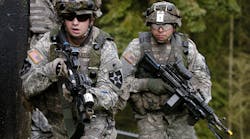‘Let’s Be Careful Out There’: What the U.S. Army Can Teach Employers About Working Safely
Every week on the groundbreaking 1980s police drama “Hill Street Blues,” Sgt. Phil Esterhaus (played by the late Michael Conrad) would conclude the roll call with this benediction: “Let’s be careful out there.”
Fast forward 25 years to forward operating bases in Iraq and Afghanistan, and you often hear the very same line from a battle-tested sergeant as he or she prepares soldiers for their dangerous daily tasks.
When applied to the U.S. Army in ground-combat operations, safety might seem out of place. After all, combat (and training for combat) is inherently risky. Soldiers get hurt because of the extraordinary and inexorable circumstances that they face for the good of their country. Safety is beyond their control ... right?
Wrong!
In the U.S. Army, leaders and soldiers at all levels constantly plan, rehearse and act to conduct dangerous activities as safely as possible, even while under the most challenging conditions. In the U.S. Army, dangerous conditions are a factor – not an excuse to disregard safety planning, policies and procedures.
Most business leaders would be startled to know that the U.S. Army’s accident rate is nearly nine times lower than the accident rate for U.S. industry. Just like any business, the Army on a daily basis drives thousands of miles, repairs heavy machinery, operates logistics depots, conducts refueling operations and operates restaurants (dining facilities). And unlike other U.S. businesses, soldiers parachute from planes, conduct shooting drills and train with complex explosives.
In the U.S. Army, leaders and soldiers at all levels constantly plan, rehearse and act to conduct dangerous activities as safely as possible, even while under the most challenging conditions.
The great opportunity for U.S. businesses is to embrace and adopt the majority of the Army’s safety techniques to improve and reduce their accident rates.
The U.S. Army’s safety practices are built on four major principles:
Common, ongoing training – In nearly every type of work, from surgery to manufacturing, any source of variability is a potential point of vulnerability. In the Army, all soldiers and leaders have a common training foundation and then a common education foundation in their particular operating specialty. Businesses can embrace common training principles for both their front-line workers as well as their leaders. A common training platform ensures that all workers understand, practice and embrace safe operating practices from their very first day.
Safety is part of everyone’s job – When an Army unit starts its daily mission, whether it’s a ground convoy or a shooting range, the day begins with a safety briefing, medical evacuation procedures and a rehearsal of the day’s most dangerous activities. Anyone – from the newest private to the seasoned sergeant – can call a safety halt if they believe there’s a danger to anyone. When everyone has a role in safety, then everyone continuously looks for ways to create a safe environment, and no one is sitting on the sidelines.
Established and universal safety planning procedures – The U.S. Army has a standard safety planning process called the Risk Management Process. The process is comprised of standard risk identification, risk mitigation and risk planning procedures that use a wide array of online tools, standard training and best-practice sharing. The use of a common procedure for all operations, widespread best-practice sharing and a focus on finding the best way to safely perform dangerous activities make the U.S. Army a leader in performing dangerous activities, safely.
The after-action review process – The U.S. Army embraces the after-action review (AAR) process. The AAR is used after every major and minor training and operational activity at all levels by all leaders, and every leader is trained on how to conduct an AAR. In the AAR, the unit allows every member to participate – regardless of rank – and the team discusses: 1) What happened; (2) What went well; (3) What didn’t go well; and (4) The plan to fix what didn’t go well. The AAR is a universal, all-encompassing team improvement process to identify areas that need to be improved and how to improve them.
The U.S. Army’s safety process is unique in that it’s a positive approach toward safety planning and safe-practice implementation.
The Army embraces safety because it realizes that the dangerous mission MUST be accomplished for the national good, and that Army personnel, material and resources are vital national assets that must be protected at all costs.
The Army embraces the concept of safety because the Army as an institution realizes not only that the dangerous mission MUST be accomplished for the national good, but also that Army personnel, material and resources are vital national assets that must be protected at all costs. Businesses should consider adopting the U.S. Army’s mindset that the only way to perform dangerous tasks in a high-risk environment is safely.
Chad Storlie is the author of “Combat Leader to Corporate Leader” and “Battlefield to Business Success.” An adjunct lecturer of marketing at Creighton University and Bellevue University in Omaha, Neb., Storlie is a retired U.S. Army Special Forces officer with more than 20 years of Active and Reserve service in infantry, Special Forces and joint headquarters units. He served in Iraq, Bosnia, Korea and throughout the United States.
